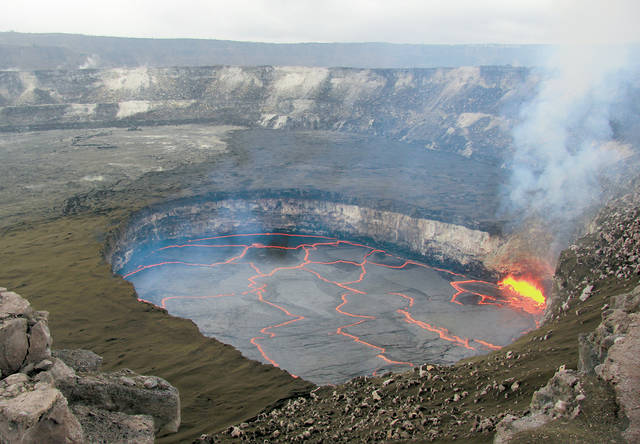Volcano Watch: New video about Kilauea’s summit eruption now online

In March 2008, a new volcanic vent opened within Halema‘uma‘u, a crater at the summit of Kilauea in Hawaii Volcanoes National Park. The eruption continues today, with continuous degassing, occasional explosive events and an active, circulating lava lake.
ADVERTISING
Because of volcanic hazards associated with Kilauea’s summit vent, the area around Halema‘uma‘u was closed to the public in early 2008 by the National Park Service and remains closed today. The hazards include high levels of sulfur dioxide gas and explosive ejection of molten lava and solid rock fragments onto the crater rim, which could cause serious injury (or worse) to anyone venturing into the closed area.
The summit eruption can, however, be safely viewed from vantage points on the rim of Kilauea Crater, such as the National Park’s Jaggar Museum overlook. From these points, the gas plume emitted from the summit vent is nearly always visible (unless obscured by fog or rain), and, on most nights, a beautiful orange glow from the incandescent lava lake can be seen. Depending on the level of the lava lake, spattering from gas bubbles bursting through the lake surface is sometimes visible from the Jaggar overlook.
The U.S. Geological Survey produced a documentary, “Kilauea Summit Eruption — Lava Returns to Halema‘uma‘u,” to tell the story of the eruption and share imagery of the inaccessible lava lake with the public. This new 24-minute video includes historical photos of past Halema‘uma‘u eruptions and stunning high-resolution footage of Kilauea’s summit lava lake — now one of the two largest lava lakes in the world.
The USGS Hawaiian Volcano Observatory, which is responsible for monitoring Kilauea eruptions and assessing volcanic hazards, was the driving force behind the documentary. HVO staff appear in on-camera interviews about the science of the summit eruption and were actively involved in behind-the-scenes production of the video.
People outside HVO also helped bring the project to fruition. For example, an interview with a Hawaii Volcanoes National Park ranger offers insights on the cultural aspects of the eruption. Additionally, the video features the voices of two well-known Island of Hawaii educators, as well as images taken by Hawaii photographers. HVO appreciates the time and talent these and other friends and colleagues contributed to the documentary.
The video begins with a chant about Halema‘uma‘u by Pualani Kanaka‘ole Kanahele, a retired kumu hula who taught Hawaiian studies at Hawaii and Maui community colleges and the University of Hawaii at Hilo and remains an icon of Hawaiian culture today. The chant expresses traditional observations of an active lava lake and reflects the connections between science and culture that continue on Kilauea today.
The documentary then recounts the eruptive history of Halema‘uma‘u and describes the formation and continued growth of Kilauea’s current summit vent and lava lake. Narration is provided by Jackie Pualani Johnson, a recently retired drama professor and chairperson of the UH-Hilo Performing Arts Department.
As the story unfolds, six HVO scientists share their insights on the summit eruption. Topics include how they monitor Kilauea’s summit lava lake, how and why the lake level rises and falls, why explosive events occur, the connection between the volcano’s ongoing summit and East Rift Zone eruptions and the impacts of the summit eruption on the Island of Hawaii and beyond.
The summit lava lake is one of two ongoing eruptions on Kilauea. The other is on the volcano’s East Rift Zone, where vents have been erupting nearly nonstop since 1983. The duration of these simultaneous summit and rift zone eruptions on Kilauea is unmatched in at least the past 200 years.
Kilauea Volcano’s summit eruption will reach its 10th anniversary in March 2018. Even now, it is the longest-lasting summit lava lake since 1924, and there are no signs that it’s slowing down. But, as noted in the video, how long it will last remains to be seen.
The new video documentary can be viewed on the USGS YouTube channel (https://youtu.be/gNoJv5Vkumk). It also is published as USGS General Interest Product 182 (https://pubs.er.usgs.gov/publication/gip182).
Funding for the video was provided by HVO, the Volcano Science Center, the Volcano Hazards Program and the Office of Communications and Publishing.
Volcano activity updates
This past week, Kilauea Volcano’s summit lava lake level fluctuated with summit inflation and deflation, ranging about 35-44 m (115-144 ft) below the vent rim. On the East Rift Zone, the 61g flow remained active, with lava reaching the Kamokuna delta and surface breakouts downslope of Pu‘u ‘O‘o. The 61g flows do not pose an immediate threat to nearby communities.
Mauna Loa is not erupting. Small-magnitude earthquakes occurred beneath the summit caldera and upper Southwest Rift Zone, primarily at depths less than 5 km (3 mi), with some deeper events at depths of 5-13 km (3-8 mi). GPS and satellite radar measurements continue to show deformation related to inflation of a magma reservoir beneath the summit caldera and upper Southwest Rift Zone. No significant changes in volcanic gas emissions were measured.
One earthquake with three or more felt reports occurred this past week on the Island of Hawaii: At 8:36 p.m. Oct. 14, a magnitude-3.6 earthquake 7 km (4 mi) west of Volcano at 6 km (4 mi) depth.
Visit the HVO website (https://volcanoes.usgs.gov/hvo) for past Volcano Watch articles, volcano updates and photos, recent earthquake info, and more. Call for summary updates at 808-967-8862 (Kilauea) or 808-967-8866 (Mauna Loa). Email questions to askHVO@usgs.gov.
Volcano Watch (http://hvo.wr.usgs.gov/volcanowatch/) is a weekly article and activity update written by U.S. Geological Survey Hawaiian Volcano Observatory scientists.


